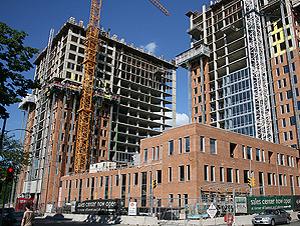Stimulus results slow in construction
(Image by Flickr user Jeramey Jannene (cc: by-nc-sa))
This story is adapted from a broadcast audio segment; use audio player to listen to story in its entirety.
Story by Peter Granitz, CNC News
Almost a complete year after Congress passed a $787 billion spending bill to jolt the economy, commercial contractors are grumbling about not seeing any results or increased work.
Economists use commercial construction, the part of the building industry that employs 60 percent of the construction workforce, as a barometer for the economy because the things they build generate money down the line: factories, offices, roads and schools.
Despite a massive addition his company is building at Omaha North High School, Chip Vrana said he expects to make less money in 2010 than he did in 2009.
Vrana said the North High addition could be the future of construction.
With four floors dedicated to science and technology, the LEED-certified building is the type of project lawmakers, including President Barack Obama, love. His stimulus plan doled out billions of dollars to projects with high upfront costs, like weatherization, promising the investments will pay off in the long run.
Vrana said he knows this but remains skeptical of a bright-green future, in large part, because last year didn’t bring in the big money he hoped for.
Commercial contractors in Nebraska laid off fewer workers last year than any other state: just four percent of its workforce. Vrana cringed at the thought of laying off more this year.
In a typical year, he said, he hires 100 trade workers: masons, carpenters, electricians. He said that probably won’t happen this year.
“We don’t anticipate brining as many people as we normally do, which is kind of sad,” he said. “Those guys look forward to returning to work and keeping their health insurance going and putting money into their pensions.”
With 60 percent of his company’s work dedicated to roads, Vrana needs to brace for a hard year: Congress crafted the stimulus so that most of the roads, highways and bridges would receive money in year one. The rest of his work comes from private building; Vrana said he expects that to decline in 2010.
“Construction costs are staying down. Materials are not rising like they were two years ago,” Vrana said. “You used to hear about drywall prices going up, your steel prices going up. But now building costs are leveling off, or even going down.”
Ken Simonson, chief economist for the Associated General Contractors of America, said government projects will prove to be the one bright-spot in 2010, even though they will not cover the losses from the private sector.
“The upturn for commercial construction may not come until 2011,” Simonson said.
When it does, he added, there will be large demand for new renewable energy projects like wind power.
Nebraska, which boasts the nation’s lowest unemployment rate at 4.5 percent, already has contractors building giant turbines. Simonson said look for an improvement in the construction of transmission lines from the power source to the end user.
Nebraska has used about one-third of the stimulus money it was awarded thus far. Other states, with higher unemployment rates, have not moved as quickly as the Cornhusker state.
Virginia also posted an unemployment rate below the national average: 7 percent. The Commonwealth spent its stimulus lot slower than any other state.
Virginia officials said they vetted each highway project carefully, slowing down the progress and preventing construction workers from turning Earth.
The state’s transportation board, the General Assembly, and the congressional delegation all weighed in on how to spend the cash.
“It is critically important that we strike a balance between putting the money into investments and infrastructure quickly but also responsibly and in a way that keeps us accountable to the taxpayer for those dollars.” Rep. Glenn Nye, D-Va., said.
The Virginia Beach Blue Dog Democrat said he’s rather the process unfold slowly.
Staffers on the House Transportation Committee compiled the list of slow-moving states. Every month it reports which states continue to lag behind.
“The idea that states would take this money and sit on it for any length of time is really counter to the original intention of the bill,” Jim Berard, a spokesman for the committee said, “[It] was to get the money moving quickly and get the people hired and jobs created quickly.”
Transportation advocates weighed in, too. Virginia Transportation Construction Alliance head Jeffery Southard blasted the state for not getting his workers back on jobsites making money fast enough.
“The old story was Virginia took a very different approach which means that were last of the gate, the new story is that you are still last, just because you were last out of the gate doesn’t mean you have to last to cross the finish line,” he said.
Across the entire country, construction associations are pushing Congress to give their industry a nod when it introduces the jobs bill that President Obama called for in his State of the Union address.
The slow-moving Senate has not passed major legislation that’s moved through the fiercely-partisan House, so a jobs bill could take considerable some time. Reports surfaced today the Senate hopes to debate a plan next week.
Overall unemployment is not expected to drop anytime soon, let alone significantly.
With no end to the recession in sight, it could prove to be a hard year for workers, but an even harder one for the people they vote for.
Created by Bureau Chief and Executive Producer Melinda Wittstock, Capitol News Connection from PRI provides insightful, localized coverage of participating stations’ congressional delegations.
